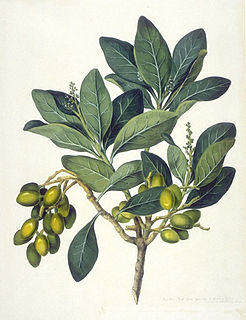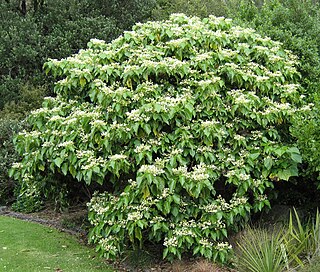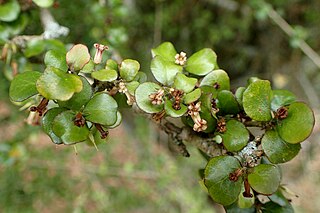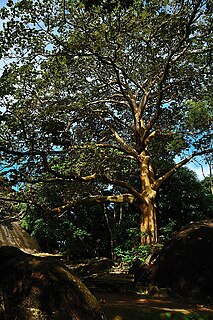
Alectryon excelsus, commonly known as titoki, is a shiny-leaved tree native to New Zealand, where it occurs in coastal and lowland forests. It is found throughout most of the North Island and from Banks Peninsula to central Westland in the South Island.

The Polynesian rat, Pacific rat or little rat, known to the Māori as kiore, is the third most widespread species of rat in the world behind the brown rat and black rat. The Polynesian rat originated in Southeast Asia, and like its relatives, has become widespread, migrating to most of Polynesia, including New Zealand, Easter Island, and Hawaii. It shares high adaptability with other rat species extending to many environments, from grasslands to forests. It is also closely associated with humans, who provide easy access to food. It has become a major pest in most areas of its distribution.

Vitex lucens, or puriri, is an evergreen tree endemic to New Zealand.

Karaka or New Zealand laurel is an evergreen tree of the family Corynocarpaceae endemic to New Zealand. It is common throughout the North and South Islands to Banks Peninsula (43°45′S) and Okarito (43°20′S), on the Three Kings Islands, on Raoul Island in the Kermadecs, and on the Chatham Islands. It is widespread in coastal habitats, often forming a major component of coastal forest, though it rarely dominates. Most botanists consider it to be native only to the northern half of the North Island, having been planted elsewhere by Māori near former village sites, and subsequently spread by birds. The common name karaka comes from the Māori language, and is also the Māori term for the colour orange, from the colour of the fruit. In the Chatham Islands, it is called kōpī, its name in the Moriori language. It is naturalised and considered invasive in Hawaii.

Rhopalostylis baueri is a species of palm native to Norfolk Island (Australia) and to the Kermadec Islands. Norfolk Island is the type locality. The common names on Norfolk Island are 'Norfolk Island palm' or 'niau'. In New Zealand the name 'Kermadec nikau' is used to refer to the Kermadec Islands population.

Entelea arborescens or whau is a species of malvaceous tree endemic to New Zealand. E. arborescens is the only species in the genus Entelea. A shrub or small tree to 6 m with large lime-like leaves giving a tropical appearance, whau grows in low forest along the coast of the North Island and the northern tip of the South Island. The dry fruit capsules are very distinctly brown and covered with spines. The common name whau is a Māori word that appears to derive from the common Polynesian word for hibiscus, other malvaceous trees which whau superficially resembles. Alternate names include 'New Zealand mulberry', 'corkwood' and 'evergreen lime'.

Ixerba brexioides, the sole species in the genus Ixerba, is a bushy tree with thick, narrow, serrated, dark green leaves and panicles of white flowers with a green heart. The fruit is a green capsule that splits open to reveal the black seeds partly covered with a fleshy scarlet aril against the white inside of the fruit. Ixerba is an endemic of the northern half of the North Island of New Zealand. Common names used in New Zealand are tawari for the tree and whakou when in flower. It is assigned to the family Strasburgeriaceae.

Elingamita is a genus in the plant family Primulaceae. It consists of a single species, Elingamita johnsonii, a tree or shrub endemic to the Three Kings Islands approximately 55 km north of the North Island of New Zealand. The entire world natural population of the tree is confined to a small rocky island and two nearby islets, and thus is vulnerable to destruction by fire or other unforeseen events. Elingamita johnsonii grows as a shrub or small tree in pohutukawa forest and coastal scrub on West island. It also occurs on two rocky islets of the Princes Group; on one of these islets, Hinemoa Rock, it grows as an emergent canopy tree in exposed places. The relationship of Elingamita to other genera of the Primulaceae remains to be properly established. Discovered in 1950, Elingamita johnsonii takes its name from the steamer Elingamite, which was wrecked on West Island in 1902. The natural range is currently free of rodents, but the fruit is known to be very palatable to rats.

Pouteria costata is a small coastal tree native to the northern North Island and to Norfolk Island (Australia). In New Zealand, its common name is tawapou ; on Norfolk Island it is called bastard ironwood. The name costata is from the Latin costatus (ribbed), a reference to the prominently raised primary nerves of the leaves. Pouteria is a genus of approximately 300 species in the tropics of America, Asia, Australia and the Pacific. A Pouteria species found in other Pacific Islands is sometimes erroneously included in P. costata.

Nestegis is a genus of flowering plant in the olive family, Oleaceae. There are five currently accepted species in the genus: three species are endemic to New Zealand, while one can be found on New Zealand and Norfolk Island. Another is restricted to Hawaiʻi.

Pittosporum obcordatum, commonly called heart-leaved kohuhu or heart-leaved kohukohu or kohukohu, is a species of plant in the Pittosporaceae family. It is endemic to New Zealand, and exists both in North Island and South Island.

Coprosma rhamnoides is an endemic shrub in New Zealand. It forms a small shrub up to 2 m tall. The leaves are very small, simple and variable in shape. The inconspicuous flowers are unisexual and believed to be wind pollinated. It is widespread in occurrence and can be the dominant small leaved divaricating shrub in some locations

Myrsine australis, commonly known as red matipo, māpou, māpau, tīpau, and mataira, is a species of shrub within the family Myrsinaceae. It is endemic to New Zealand, found throughout both the mainland and offshore islands.

Sterculia apetala, commonly known as the Panama tree, camoruco, manduvi tree or anacagüita, is a species of flowering plants in the family Malvaceae. It is found in Central and South America, as well as the Caribbean islands. Sterculia apetala is recognized as the national tree of the Republic of Panama.

Pomaderris apetala is a small tree or large shrub from the family Rhamnaceae, growing in Victoria, New Zealand and Tasmania.

Carpodetus serratus is an evergreen tree with small ovate or round, mottled leaves with a toothy margin, and young twigs grow zig-zag, and fragrant white flowers in 5 cm panicles and later black chewy berries. It is an endemic of New Zealand. Its most common name is putaputaweta which means many wētā emerge - referring to the nocturnal Orthoptera that live in holes in the trunk of this tree. Regional variations on the name also refer to this insect that lives and feeds on it such as kaiwētā, and punawētā. The tree is also sometimes called marbleleaf. It is found in broadleaf forest in both North, South and Stewart Islands. It flowers between November and March, and fruits are ripe from January to February.

Nestegis lanceolata, commonly called white maire, is a tree native to New Zealand.

Parsonsia heterophylla, commonly called New Zealand Jasmine or Kaihua, is a climbing plant endemic to New Zealand.

Griselinia lucida, commonly known as puka, akapuka or shining broadleaf, is an epiphytic plant native to New Zealand. G. lucida naturally occurs in wet lowland-forests and open or rocky coastal environments mostly in the North Island of New Zealand, and restricted areas of the South Island.





















